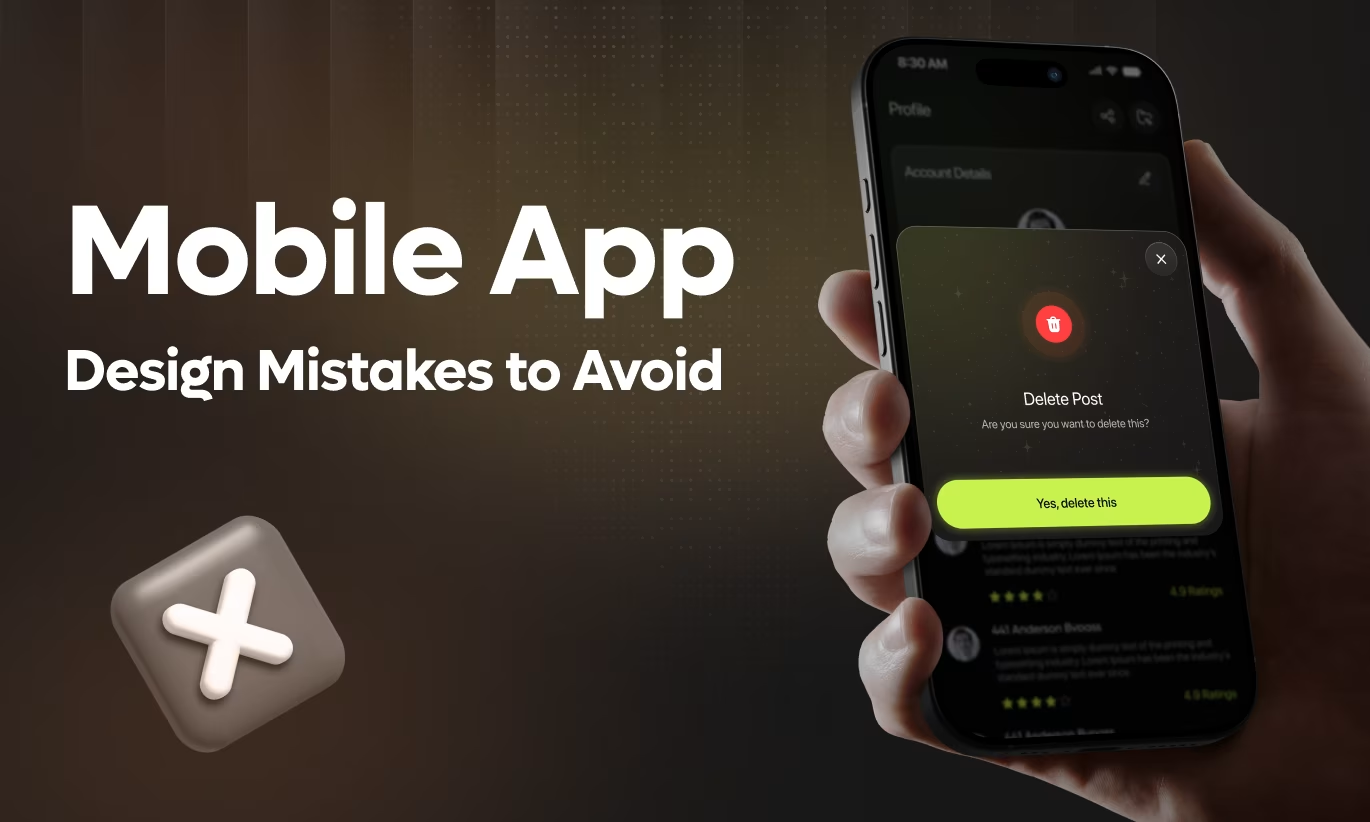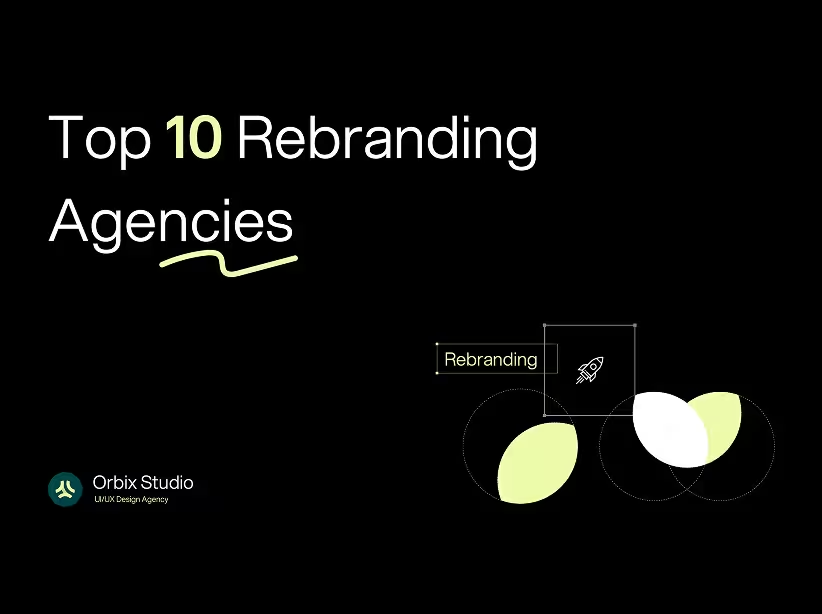Table of Contents

Mobile apps have become essential to how users interact with digital products, yet 25% of downloaded apps are used only once. Poor design is the primary culprit. Understanding common mobile app design mistakes—and how to avoid them—can mean the difference between an app that thrives and one that gets deleted within minutes.
In this guide, we'll explore critical mobile app design mistakes and provide actionable solutions to help you create apps users love.
1. Ignoring Platform-Specific Design Guidelines
The Mistake: Creating identical experiences for iOS and Android without respecting platform conventions frustrates users who expect familiar patterns.
Why It's Problematic: iOS users expect tab bars at the bottom and back buttons in the top-left. Android users look for navigation drawers and floating action buttons. Violating these conventions creates cognitive friction.
The Solution: Design natively for each platform while maintaining brand identity through colors and typography. Follow Apple's Human Interface Guidelines for iOS and Material Design principles for Android. Instagram successfully maintains its brand while offering platform-specific experiences—their iOS app uses iOS-standard share sheets while Android implements Material Design patterns.
2. Poor Onboarding Experience
The Mistake: Bombarding new users with lengthy tutorials or forcing account creation before showing value drives immediate abandonment.
Why It's Problematic: You have approximately 3 seconds to capture user interest. Apps with optimized onboarding see 50% higher user retention rates.
The Solution: Implement progressive onboarding that shows value first. Let users explore core features before requiring sign-up, request permissions contextually with explanations, and use interactive tutorials instead of static screens.
Orbix Approach: When we redesigned a fintech client's onboarding, we reduced the initial tutorial from 7 screens to 2, moved account creation after demo exploration, and saw a 43% increase in day-1 retention.

3. Cluttered and Overwhelming Interfaces
The Mistake: Attempting to display too much information on a single screen creates visual chaos, especially when trying to replicate desktop experiences on smaller mobile screens.
Why It's Problematic: Mobile screens average 5-6 inches diagonally. Cluttered interfaces increase cognitive load, slow decision-making, and make apps feel complicated.
The Solution: Apply the 80/20 rule—identify the 20% of features that deliver 80% of value and prioritize those. Use progressive disclosure to hide advanced options, implement cards and sections to break information into digestible chunks, and utilize white space generously.
Orbix Approach: When we redesigned a fintech client's onboarding, we reduced the initial tutorial from 7 screens to 2, moved account creation after demo exploration, and saw a 43% increase in day-1 retention.
4. Neglecting Touch Target Sizes
The Mistake: Designing buttons and interactive elements that are too small to tap accurately causes mis-taps and frustration.
The Solution: Follow established guidelines with a minimum size of 44x44 pixels (iOS) or 48x48 pixels (Android) for all tappable elements. Maintain at least 8 pixels between adjacent touch targets and consider thumb zones when placing primary actions.
Orbix Approach: During an audit for an e-commerce client, we increased their "Add to Cart" button from 32x32 to 48x48 pixels. Cart abandonment dropped by 18% and accidental taps decreased by 67%.
5. Slow Loading Times and Poor Performance
The Mistake: Apps taking more than 3 seconds to launch create negative first impressions. 53% of users abandon slow apps immediately.
The Solution: Design for perceived speed using skeleton screens instead of blank loading states. Implement lazy loading, optimize images using WebP format, cache frequently accessed data, and set performance budgets with maximum loading times under 2 seconds for launch and under 300ms for screen transitions.
6. Inconsistent Navigation Patterns
The Mistake: Using different navigation patterns across screens or placing buttons in unexpected locations confuses users and creates disjointed experiences.
The Solution: Choose one primary navigation pattern and maintain it throughout. Keep primary actions in predictable locations, use standard icons, implement clear back navigation, and create a comprehensive design system that documents all patterns.
7. Overusing Notifications and Interruptions
The Mistake: Bombarding users with excessive push notifications is the fastest way to get your app uninstalled. Apps sending more than one notification per week see 15% higher uninstall rates.
The Solution: Make notifications valuable by only sending genuinely useful messages. Allow granular control over notification types, implement smart timing using machine learning, and provide easy opt-out options. Duolingo masters this with a single daily reminder at user-selected times.
8. Poor Typography and Readability
The Mistake: Using fonts that are too small, insufficient contrast, or cramped line spacing makes content difficult to read, especially for users with visual impairments.
The Solution: Use a minimum 16px font size for body text, maintain 4.5:1 contrast ratios for normal text, set line height at 1.5x the font size, and always support dynamic type so users can adjust text size to their needs.
9. Ignoring Error States and Edge Cases
The Mistake: Designing only for the "happy path" without considering what happens during network failures, empty states, or form validation errors leaves users stranded.
The Solution: Create specific error messages explaining what went wrong and how to fix it. Design welcoming empty states for new users with clear calls-to-action, provide inline form validation, and maintain core functionality offline when possible.
Orbix Example: For a travel booking app, we designed 15 different error states including network failures and payment issues. Each provided specific guidance, reducing support tickets by 34%.
10. Complicated Forms and Input Fields
The Mistake: Creating lengthy forms with too many fields and poor validation creates tedious experiences. Each unnecessary field increases abandonment risk.
The Solution: Minimize fields to only essential information, use appropriate input types (number pads for phone numbers), implement auto-fill support, break long forms into multi-step processes, and provide inline validation. Studies show reducing form fields from 11 to 4 can increase conversions by 120%.
11. Lack of Feedback and Confirmation
The Mistake: Not providing immediate visual or haptic feedback leaves users uncertain whether their action registered, potentially causing duplicate submissions.
The Solution: Implement visual feedback with button state changes, use haptic feedback for confirmations, show loading indicators for operations over 1 second, provide clear success messaging, and implement two-step confirmation for destructive actions.
12. Weak Visual Hierarchy
The Mistake: Treating all elements as equally important creates flat interfaces where users can't identify where to focus attention, reducing conversions.
The Solution: Make important elements larger, use accent colors for primary actions, place critical content in the top third of the screen, increase contrast for emphasized elements, and use generous white space around important items.
13. Ignoring Accessibility Requirements
The Mistake: Designing only for users with perfect vision and motor control excludes 15% of the global population with disabilities and misses significant market opportunities.
The Solution: Provide meaningful labels for screen readers, ensure 4.5:1 minimum contrast ratios, don't rely on color alone to convey information, test layouts at 200% text size, and test with VoiceOver (iOS) and TalkBack (Android). The disabled consumer spending power exceeds $8 trillion globally.
14. Copying Competitors Without Understanding Context
The Mistake: Blindly implementing features from successful apps without understanding why they work creates disjointed experiences.
The Solution: Research why successful apps made specific decisions, conduct user research to understand your audience's unique needs, test borrowed patterns, and adapt solutions to fit your context rather than copying directly.
Orbix Research Process: We conduct competitive analysis paired with user interviews and usability testing to ensure borrowed patterns serve our clients' specific users and business goals.
How to Avoid Mobile App Design Mistakes: Strategic Approach
Avoiding these mistakes requires systematic methodology:
Invest in User Research: Conduct user interviews, usability testing, and analytics review. Build personas based on real data, not assumptions.
Create a Design System: Document component libraries, interaction patterns, platform-specific guidelines, and accessibility standards.
Prototype and Test Early: Build interactive prototypes before development, test with 5-8 representative users per iteration, and validate on multiple devices.
Measure and Optimize: Track time to complete key tasks, error rates, feature adoption, user retention, and app store ratings.
The Cost of Poor Mobile App Design
Poor mobile app design has measurable business impact. 21% of users abandon apps after one use, poor UX costs companies $62 billion annually, and 88% of users won't return after a bad experience. Conversely, every $1 invested in UX returns $100—an ROI of 9,900%.
Ready to Elevate Your Mobile App Design?
Avoiding mobile app design mistakes requires expertise and deep understanding of platform guidelines and user psychology. Professional guidance makes the difference between struggling apps and thriving ones.
At Orbix Studio, we specialize in mobile app design that balances beautiful aesthetics with exceptional functionality. Our team has helped dozens of startups and enterprises avoid costly design mistakes, improve retention, and drive measurable results.





